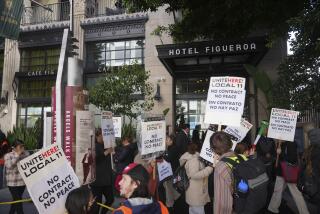Community, Developers Agree on Staples Plan
Ending the threat of widespread opposition, the developers of a major hotel and entertainment center around Staples Center have agreed to an unprecedented package of concessions demanded by community groups, environmentalists and labor.
The developers--including billionaire Philip Anschutz and media mogul Rupert Murdoch--agreed to hire locally, provide “living wage jobs” and build affordable housing and new parks. The deal is scheduled to be announced today after months of confidential negotiations.
The billion-dollar project is seen as vital to the revitalization of downtown Los Angeles. Known as the L.A. Sports and Entertainment District, it would be anchored by a 45-story hotel with at least 1,200 rooms at Olympic Boulevard and Georgia Street. The project also would include a 7,000-seat theater for musicals, award shows and other live entertainment. Restaurants, nightclubs and retail stores would be built around a plaza.
A 250,000-square-foot expansion of the adjacent Los Angeles Convention Center also is in the plan, as well as two apartment towers with a total of 800 units and a second smaller hotel.
The deal brokered with the coalition of activist groups, unions and residents, which will become part of the development agreement, is believed to be the first of its kind nationwide to take such a broad array of community concerns into account, according to economic and community development experts. Union and neighborhood leaders are hopeful that it will serve as a blueprint for similar projects, particularly when hefty public subsidies are involved.
“I’ve never heard of an agreement that’s as comprehensive as this,” said Greg LeRoy, director of the Washington-based Good Jobs First, a national clearinghouse that tracks the public benefits of economic development projects. “What’s unusual here is that [housing, employment and open-space provisions are] all together. . . . It’s really a model.”
The development partnership, led by the Los Angeles Arena Land Co., also owns Staples Center. That project received Los Angeles city approval in 1997 on the condition that the developers eventually build the massive complex to help the Convention Center attract more business.
But community opposition posed a serious threat, in part because the hotel project likely will require a city subsidy that could exceed $75 million. While scattered resistance may yet emerge, the developers now can claim the backing of the groups most affected by the development, including 29 community groups, about 300 predominantly immigrant residents of the neighborhood and five labor unions.
“I think the City Council has to be pleased with that . . . because those are the people who will be most impacted,” said John Sheppard, land use planning deputy to Councilwoman Rita Walters, who represents the neighborhood and arranged the first meeting between community groups and Arena Land President Tim Leiweke last fall.
Next week’s city elections added urgency to the mix. Marching orders for Ted Tanner, senior vice president of Staples Center and Arena Land--the main developer--were to secure all city entitlements by the end of June. Getting the community on board, and avoiding a protracted fight, was “extremely important,” he said.
The city Planning Commission approved the plan May 23. It is scheduled for a vote before the Community Redevelopment Agency next week and then moves to City Council.
The approach on both sides of the table stands in marked contrast to the way things went down when Staples Center rose from the ground just two years ago. Then, the community was neither organized nor informed enough to act, and Staples officials now concede they were insensitive to community needs.
Still, the new deal did not come easy. Many coalition members are more accustomed to protest than to the 100 hours of labor-style negotiations that ultimately produced the package. Early relations were rocky. When Leiweke canceled plans to attend the first meeting with residents last October, organizers placed his name placard on an empty chair, addressing him angrily in his absence.
But the tone changed over time as mutual trust built. By March, Tanner--who had been anointed lead negotiator by Leiweke--delivered an update to residents in accented Spanish, and was met with applause.
Tanner said the difficulty in negotiations was in striking a balance--to meet the demands of the coalition without burdening the development or its tenants with costly conditions not required elsewhere.
“Our goal in continuing negotiations was to win true support and advocacy for the project,” said Tanner, an architect who early in his career sat across the table from community groups on urban planning projects in Philadelphia. “Their goal was the same--to see if we could make this project better and improve benefits for the community.”
For community groups, unions and residents, however, the deal has even broader implications. The effort, they say, has yielded the most tangible results yet of a nascent strategy to serve the overall interests of neighborhoods.
“It’s a huge step forward,” said Madeline Janis-Aparicio, executive director of the Los Angeles Alliance for a New Economy and one of the lead community negotiators. “Bringing all these groups together showed how housing relates to jobs relates to environment. These are holistic people with holistic needs, and to have a developer take that into account . . . is just amazing.”
Among the highlights of the deal:
* More than $1 million for the creation or improvement of parks within a mile of the project, with community input; a one-acre public plaza and other public open space.
* At least 70% of the estimated 5,500 permanent jobs to be created by the project--including those offered by tenants--will pay a living wage or better. Those are defined as paying $7.72 an hour with benefits or $8.97 without, or covered by collective bargaining agreement. The deal also calls on the developer to notify the coalition 45 days before signing tenant lease agreements.
* A local hiring and job training program for those displaced by the arena, living within three miles of the project or living in low-income areas citywide. Developers will give $100,000 in seed funding to create specialized job training programs through local community groups and ensure that appropriate residents are notified first of jobs.
* A residential parking permit program, financed by developers for five years, that will reserve street parking for residents. Common in affluent areas, officials say it will become the first parking permit zone in a low-income neighborhood.
* Construction of between 100 and 160 affordable housing units, or 20% of the total project. Those will be affordable to residents earning below 50%, 60% and 80% of the area’s median income. The units exceed Community Redevelopment Agency requirements in number and serve families with lower incomes. Developers also will provide up to $650,000 in interest-free loans for nonprofit housing developers in the early stages of developing projects in the area.
Some of the 29 community groups that came together as the Figueroa Corridor Coalition for Economic Justice had worked together before, helping to organize union efforts at USC. The alliance broadened beginning last summer to include everyone from local churches and housing activists to environmentalists, tenant organizers and immigrant rights groups.
Meanwhile, residents began to organize too, coming together to air concerns over conditions around the existing arena, where reckless drivers, costly parking tickets, and vandalism have plagued their lives.
Labor, too, played a key role--with two unions representing hotel and restaurant workers and janitors joining the community coalition as part of an effort to expand their influence beyond wage issues.
They are among five unions negotiating jointly for union jobs and the right to organize at the new center under the direction of Los Angeles County Federation of Labor leader Miguel Contreras.
Realizing that the window of opportunity was small and closing, coalition members opted to link up with labor to further leverage their power, said Gilda Haas, director of Strategic Actions for a Just Economy, one of the lead organizations in the coalition.
When disagreements stymied the progress of the janitors’ union, community negotiators stood in unison with labor. In turn, labor chimed in on issues such as affordable housing, which affects their membership but was not technically on their agenda.
“I kept thinking of this as two airplanes approaching an airport at the same time,” said David Koff, a hotel union research analyst who served as an official County Federation of Labor observer in the community negotiations. “The idea was to get both to make a soft landing at the same time.”
The unions, which also represent parking lot attendants, stagehands and operating engineers, are expected to announce their finalized agreements soon. But labor sources said most of the core issues have been resolved, due in part to the coordinated approach to negotiations.
“What we’re hoping is to get work, to get housing, to have a better way of living,” said Manuel Pacheco Galvan, who hopes to trade his job at a Hollywood market for one closer to home. “Almost everything we asked for we got. . . . In the beginning it didn’t seem possible, but now we see that it’s a reality. This will mean some change for all of us.”
More to Read
Sign up for Essential California
The most important California stories and recommendations in your inbox every morning.
You may occasionally receive promotional content from the Los Angeles Times.











